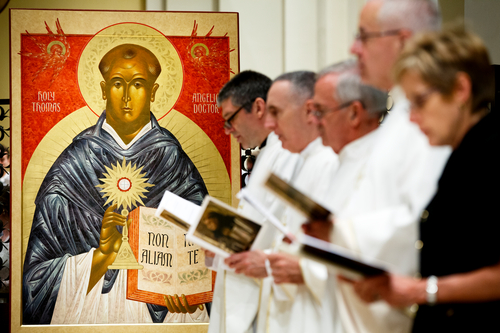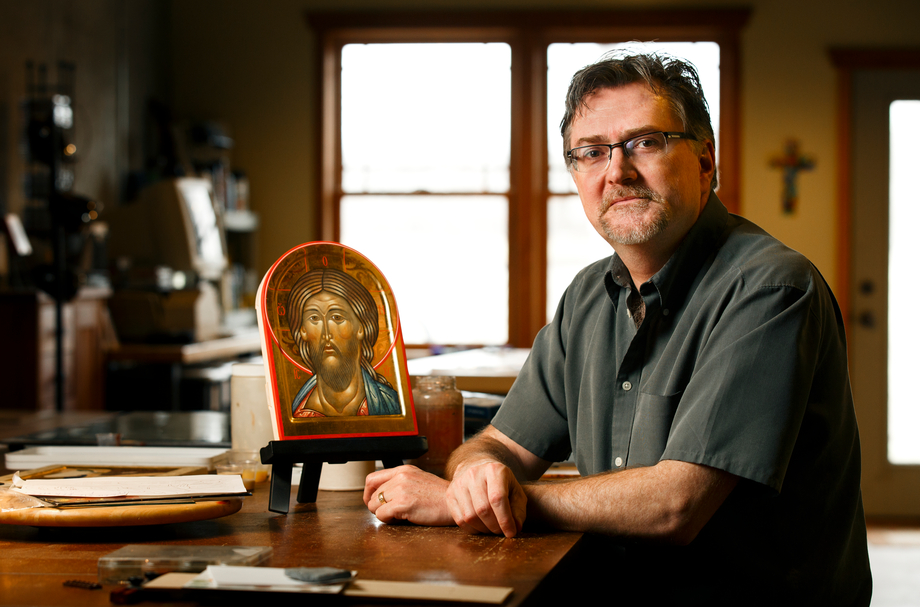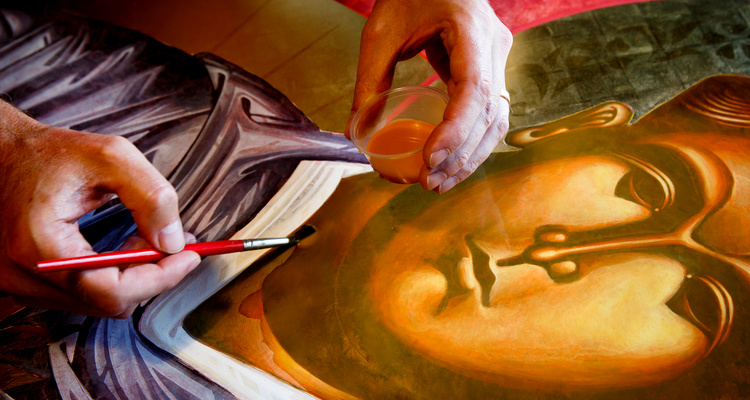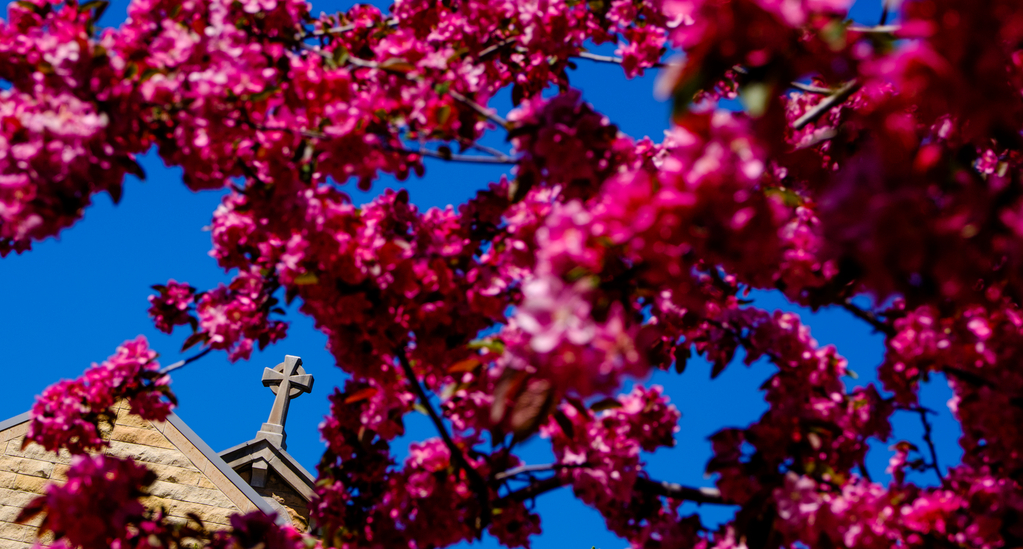An icon: Holy Thomas – Angelic Doctor
“To gaze upon an icon is to remember our future.”
Iconographer Nicholas Markell ’84 attributes this wisdom to St. Gregory and points out that when gazing upon an icon it should help us remember that we’re called to become transfigurative – just like the saint depicted in the icon.
In this case, the icon that can be gazed upon is that of St. Thomas Aquinas, the university’s patron saint. Markell created (or “wrote”) it, and it was presented to Campus Ministry on Sunday during the annual Opening Mass. The icon stands 5 feet 5 inches tall and 3 feet 9 inches wide.

The icon of St. Thomas Aquinas was presented to Campus Ministry at the university's annual Opening Mass, which was celebrated Sunday, Sept. 8.
Markell spent about six-months “writing” the icon once the final sketch was approved, a length of time not uncommon for such an involved process. (“Writing” is the word used to describe the process of creating an icon.) The final sketch was developed after an extensive collaboration between the artist and numerous consultants on campus.
An icon is “primarily a vehicle of prayer,” Markell explained in an interview last spring as he was writing the icon. “I want it to be an image where people can come before it and more readily and more fluently and more graciously experience God’s love and grace in their lives.”
“We wanted a visual identifier for the Campus Ministry office in the Anderson Student Center. An icon of St. Thomas Aquinas seemed the perfect idea,” said Father Erich Rutten, chaplain and director of Campus Ministry, “and, as an alumnus and a holy man himself, we felt Nick would capture St. Thomas the best.” The icon will be placed later this week in a prayerful place in Campus Ministry and available for prayer and veneration, as well as for various liturgies and processions.
Icons are common in Eastern culture and somewhat of a mystery to the faithful in Western culture.
“I would say a way to understand an icon is it’s a spiritual portrait,” Markell said. “It isn’t so much what the person looked like, although that’s important, but who are they in Christ? What is their spiritual identity – or their spiritual characteristic? That’s really what you’re communicating in an icon.”
An icon is “not so much a style of art as it is a vision of reality,” according to Markell. An icon relies on symbols, and numerous symbols were explored for this icon. Five were selected specific to St. Thomas Aquinas:
- Monstrance (tabernacle) with the Eucharist
- Angels – two six-wing seraphim, which are associated with worship
- The name and title: Holy Thomas – Angelic Doctor
- Symbols of humility – violet petals and vines burnished within the nimbus (halo) and on the book
- An open book with the school’s motto: Non aliam nisi te – “Only you, Lord” or “None other than you, Lord”
“When I look at St. Thomas, all the different ways in which that image is rendered helps me to realize that I am called to be like Thomas,” Markell said. “I am called to become complete, harmonized, beautiful, a re-created person in Christ, and the icon helps us to remember that future.”

Nicholas Markell wrote the St. Thomas Aquinas icon in his studio in Hugo, Minn.
In the beginning
A discernment to ministry sparked his interest in icons. “In the later years at St. Thomas I had a conversion experience, I guess you could say,” Markell recalled.
Following his graduation from St. Thomas with a B.A. in fine art (his fine art classes were taken at the College of St. Catherine with an emphasis on painting), Markell studied as a Paulist seminarian for six years. It was in his novitiate year, when Eastern Europe was opening up, when Communism was fading and awareness of Eastern Orthodoxy was increasing, that he discovered his calling to write icons.
Markell was not ordained, but he earned two graduate degrees from Washington Theological Union: a Master of Divinity and a Master’s of Art in Sacred Theology with an emphasis on spirituality. He wrote his first icon during his novitiate year.“I didn’t know much about icons until I entered the seminary, and I went to a Catholic college – so what does that say about an awareness we have of what the icon really is?” Markell remarked.
“I think the first icon I did – it was of St. Paul – wasn’t very good. I didn’t do a lot of things iconographically right, and so forth, but I would say that in the entire experience of doing it I realized that this was a fit,” Markell said.
He wrote several more icons while in the seminary and later studied with two iconographers; one was a Russian emigrant. Most of his icons since have been in the Russian style, which is more intensely symbolic and every step has a particular meaning and purpose.
“I’ve varied it a little bit and kind of go on my own now, but it’s what would be called Russian mystical icon writing,” said Markell, who estimates that he has written 100 icons, many quite large church commissions. “The difference from others is the style, a little bit, and also the symbolism behind it – What is it you are bringing forth in the image? What is it that you are revealing in the image? So it’s more the mystical part of the church or the mystical part of participation in the church.”
Creating the icon
Each step in the process of creating an icon has a symbolic meaning. Markell points out that the creative process is liturgical in a sense. A Mass doesn’t skip parts of the liturgy and go right to the Eucharist because there is value the preparation.
"Theologically, spiritually and liturgically we value every step in the ritual of the liturgy. The Mass has a purpose that fertilizes the ground, if you will, from which we can receive the Word and have it sink in and then we can participate in the Eucharist.” Markell explained. “So in the same way here, there are many, many steps and each one has meaning that prepares you for that final completion.
“You move from dark to light, so that’s why you see all the base coats down here first. All the darkest colors are down first. It’s symbolic of Genesis, where God's spirit hovers over the face of the waters – there is an abyss, a dark abyss. It’s not evil; it’s beautiful. It’s like this big color has a certain kind of marbleized quality but needs light.”
One can write an icon only of a person who is in heaven, and writing is a religious experience.
“It can be very prayerful. It can be my prayer for the day. To remember, OK, this step – when first light comes – what does that mean for me? A certain kind of awareness. Second light – light of the soul. What does that mean? It keeps me closer to what I am doing and keeps the process more pure so that I step out of the way. Kind of like a master of ceremonies. … A master of ceremonies does a good job if you don’t know they’re there.”
Breathing life into the icon
One of the more interesting and exhausting stages of writing is the breathing required to apply gold on a base of clay to the icon. It is both symbolic and important, and the foundation for everything the iconographer brings to the project.
“The foundation is the fact that God is there to share divine light with us,” Markell said, noting that the breathing and burnishing process is symbolic of God breathing life into Adam, “made of clay, of the earth, and we can see ourselves in Adam and Eve.”
Gold is a symbol of divine light, the light of heaven, it’s our most precious metal, and it picks up light in an other-worldly way, Markell pointed out. “On every area of that clay, that gold is put down by me breathing three deep breathes onto clay. It has natural glue in it. It’s activated by my moist, hot breath. I place the gold leaf over the clay and burnish it down. It takes a month or two just to do the gold,” he said.
Theology of iconography
As an iconographer, Markell’s goal is to “present a life-giving message, rooted in the common faith of the church, that is a reliable guide for all.”
“What you’re doing is something very profoundly theological. You’re making a doctrinal, dogmatic, theological statement, a liturgical statement, about not only what we believe about the transfiguration of Christ but what does it mean for our common faith,” Markell said. “So, I would compare an iconographer as much to a minister as an artisan. We are like an ordained priest in a sense. We have been trained so that even though our personalities and gifts are put at play, we are a spokesperson for the common faith, and that’s how I would see my role as an iconographer.”

In addition to writing icons, Nicholas Markell also paints wildlife. In 2012 he won Minnesota’s Trout and Salmon Stamp Contest, and in 2013 he won Minnesota’s Walleye Stamp Contest. The contests are sponsored annually by the Minnesota Department of Natural Resources.
We are called to be icons
While an icon is both a “vehicle of prayer” and a “spiritual portrait,” it also calls the observer to become an icon. “If we can enter into the journey of St. Thomas himself, it might help us enter into that same journey,” Rutten said.
Markell expressed a similar thought: “The icon helps me to be more authentic, more transparent, more of an icon in the world. I’m called to be an icon, so as I do this it makes me aware. What is God doing to me? God is re-creating me so that I can be a more transparent witness. ... That’s what we’re all called to do in some fashion – so that when people encounter us in some way it is to encounter the light of Christ.”
Markell also sees the icon as a medium to contemplate the value of a St. Thomas education: “It will be a wonderful opportunity now to help those viewing it, students particularly, to see that all of their training, all of their education, if it doesn’t result in them saying ‘Only you, Lord’ – what this is really all about – what was the value ultimately?
* * *
Editor’s note: Nicholas Markell will discuss the creation of the St. Thomas Aquinas icon during convocation hour on Tuesday, Sept. 24, in O’Shaughnessy-Frey Library.







